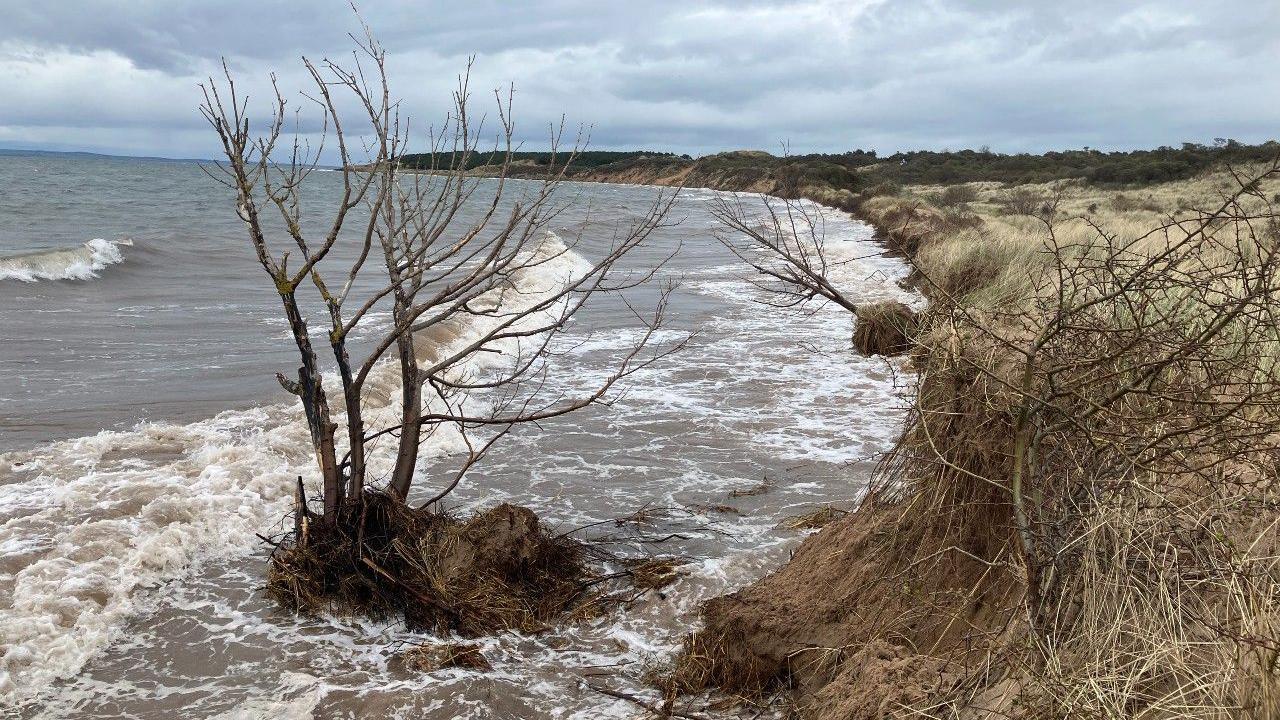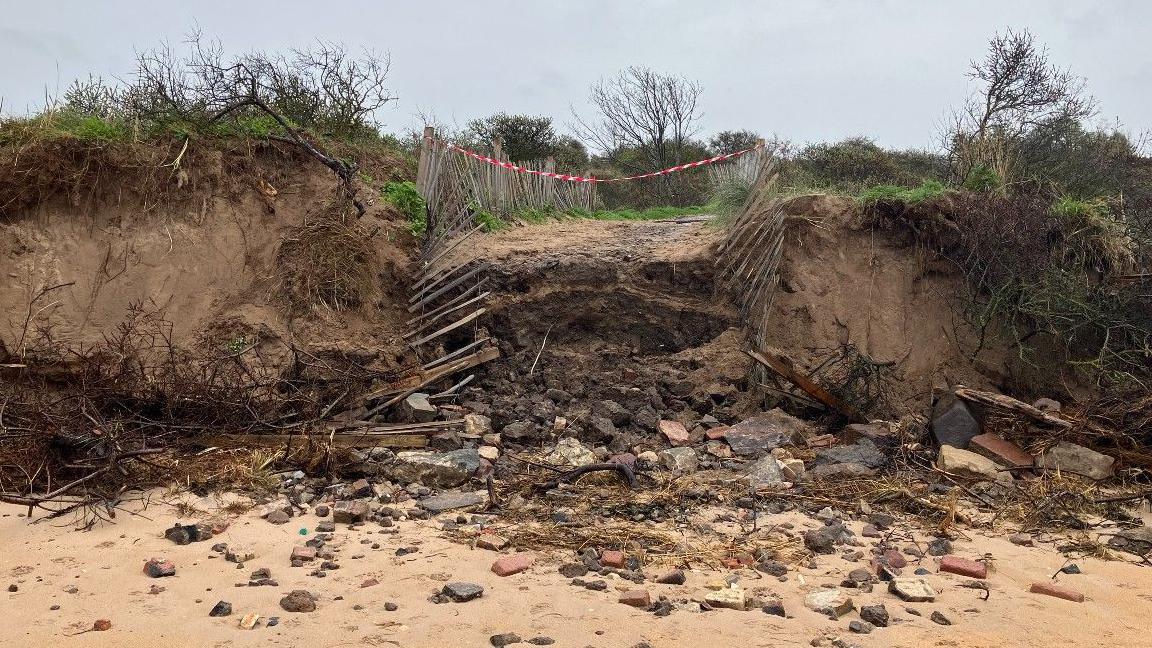The Scottish beaches with the missing sand

The beach and the dunes at Gullane have serious damage from recent storms
- Published
Many of Scotland's beaches are still bearing the scars of a series of severe storms that have blasted the country in the past eight months.
Some have suffered a severe loss of sand and damage to adjacent structures such as paths and harbours.
Coastal experts are warning that they may not have enough time to recover before the next bad weather comes along.
Laura Douglas is a senior countryside ranger with the East Lothian Council Ranger service.
She said in her twenty-plus years of experience she had never seen this amount of damage along the coastline because of the weather, which has affected the area's famous sand dunes.

Colin Cornwall from Portobello shows where the sand level used to be
Laura says: "In some areas, particularly here at Gullane, we've had more than 10m depth of dune that's gone.
"We've been able to estimate that, particularly at Yellowcraig, that's probably 80 years' worth of dune development just because of the amount of material that's coming out.
"Within that we've also lost a lot of the sea buckthorn that grows here on the dunes. A lot of that has been pulled out which holds the dunes together so it's having a massive impact on the dunes system here. "

Erosion of the dunes on the beach at Gullane
The loss of so much sand has exposed some remnants from World War Two, and the remains of an old military ship dating back to about 1881.
Laura fears the frequency of storms has made the coastline particularly vulnerable.
"There isn't a lot of time in between storms for the sand dunes to redevelop. If the dunes system can't redevelop, the height won't be the same. There's a real change all the way along the coast."
A few miles to the west at Edinburgh's Portobello beach, some locals are shocked by the amount of sand that has been washed away.
Colin Cornwall has lived here all his life, and regularly does a litter pick on the beach. He says it is the worst he has seen.

A shipwreck has been uncovered due to erosion at Broadsands
"We've lost a lot of sand - six or seven feet in places. There's a 10ft drop at part of the defence wall and that was about three foot from the wall to the sand.
"My granddaughters used to jump down on to the sand - but now it's about a nine or 10ft drop. The sand hasn't just shifted along the beach - it's gone back out to sea.
"That's just not going to be washed back in by the tides."
He added: "It's been bad before but and it's corrected itself without anyone being called in to do it - the beach has sorted itself out. I know there are people saying that it happens all the time - but not to this extent. I'm very worried. It can't go on like this.
"Sand moves, I understand that, but here's no way that six or seven foot of sand is going to be miraculously washed back in."

The sand level at Portobello beach has dropped by several feet in places revealing much more of the walls
Storm Babet crashes into Scotland... in 60 seconds. Video, 00:01:00
- Published19 October 2023
Named storms such as Babet and Ciaran have battered Scotland over the past eight months, particularly on the East coast.
There have been eleven of them since September. The Scottish government's Dynamic Coast project is looking into the impact of the weather on our beaches.
Dr Alistair Rennie is the project manager. He says beaches have the capacity to repair to some extent, but the number of storms we've seen is making that recovery more difficult.
"That frequency really hurts because it doesn't give the natural systems quite enough time to recover and repair themselves.
"It is a concern and as we look at climate change we should expert more of these sorts of impacts.
"We need to invest in all forms of resilience, whether that's repairing sea walls or replenishing our beaches.
"But also adapting - trying to get used to these sorts of storms and making ourselves more resilient as communities, as businesses and infrastructure owners."

Erosion has seen a collapse to the beach path at Gullane in the past week
Councils are now putting together coastal change adaption plans, to deal with the impact of rising tides and stormier seasons.
Ian Chalmers from East Lothian's structures and flooding team says they need a strategy for future severe weather.
"Some of the coastal erosion that we're experiencing is relatively unknown," he said.
"So we need to understand which areas are going to be worst affected and from that we can look at adaptations.
But what we are seeing is that we're losing sand on all of our beaches so where do we actually bring that sand in from?
"It's looking at that kind of longer term plan as to whether there's anything else we can do."
He also said that it would be essential to monitor and understand key risks along our coastlines, what kind of infrastructure is going to be affected, before putting measures in place.
Many councils are keeping a close eye on how key beaches recover, and using Scottish government funding to plan ahead and prepare for the expected storms of the future.
But there is a worry that beaches will not have enough time to repair before the next series of extreme weather events.